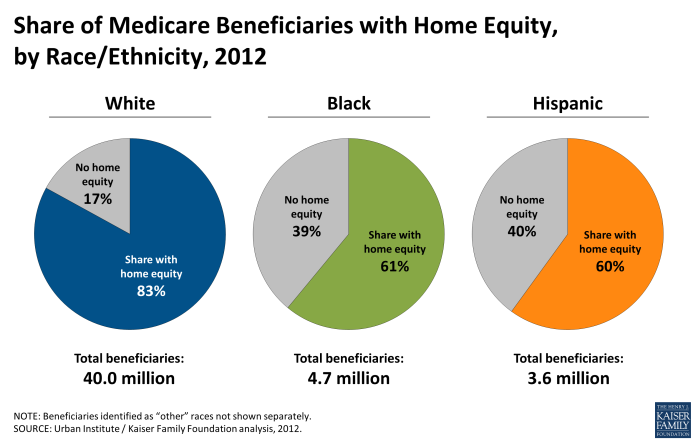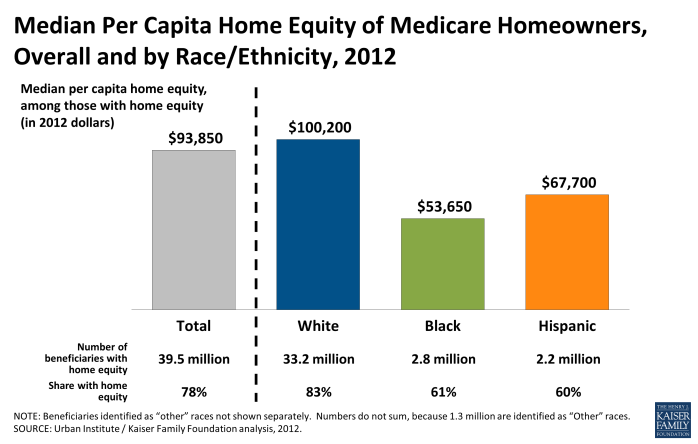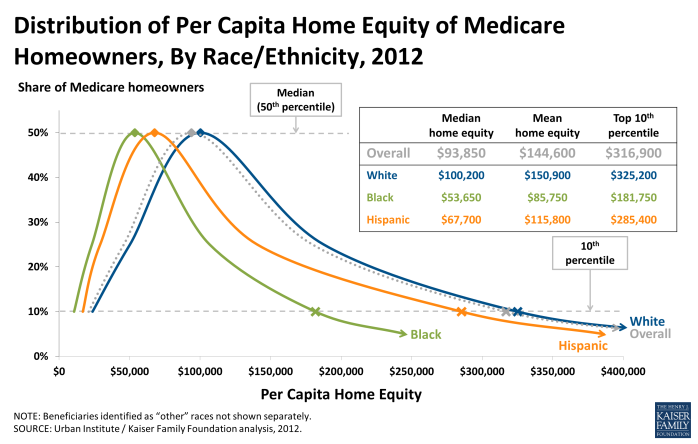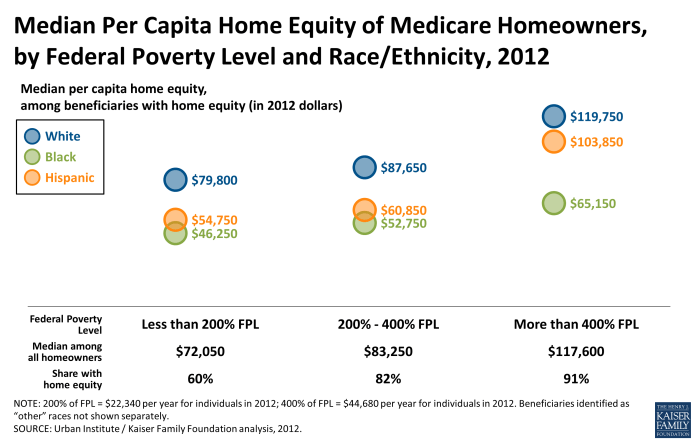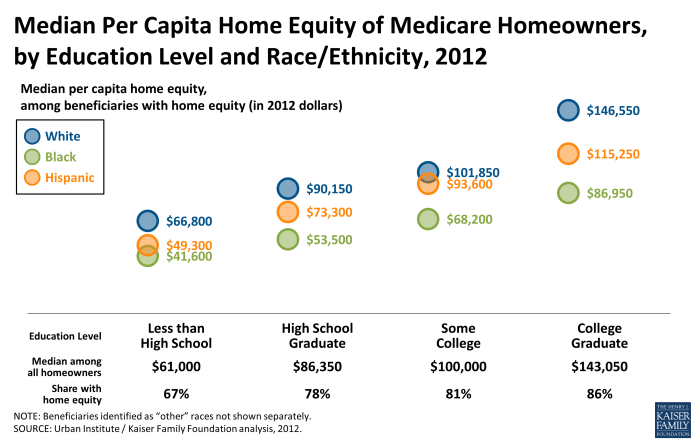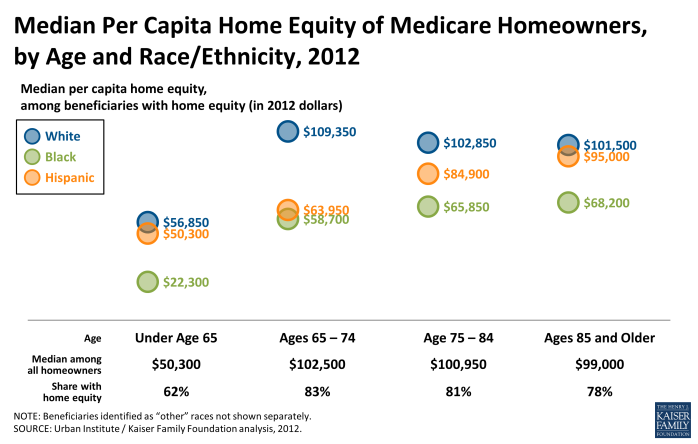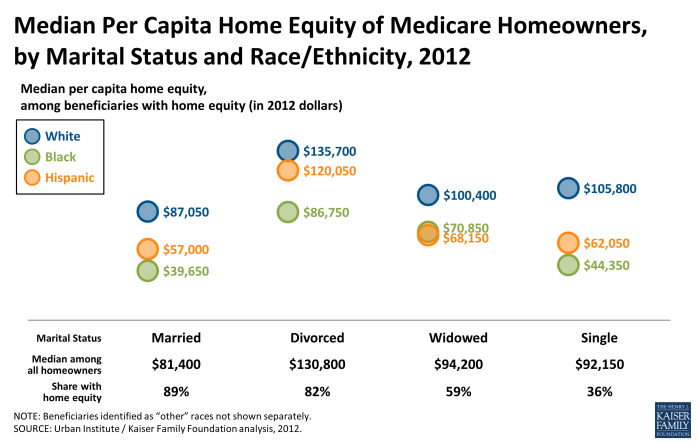Wide Disparities in the Income and Assets of People on Medicare by Race and Ethnicity: Now and in the Future
Section 3: Home Equity
This section describes the home equity of the Medicare population across race/ethnicity in 2012, including the share of beneficiaries with home equity, and the home equity values among beneficiaries who have any home equity. As with income and savings, home equity values are divided equally between spouses to calculate per capita home equity. The home equity values shown account for any decrease in home equity values that occurred as a result of the mortgage crisis; it has been estimated that more than 1.5 million Americans over age 50 lost their homes between 2007 and 2011.1
Key Findings:
- In 2012, most Medicare beneficiaries (78%) had some home equity, with higher rates among white beneficiaries (83%) than among black or Hispanic beneficiaries (61% and 60%, respectively).
- Among beneficiaries who had home equity, half of all beneficiaries had less than $93,850 in home equity in 2012; median home equity values were significantly higher among white beneficiaries ($100,200) than black or Hispanic beneficiaries ($53,650 and $67,700, respectively) in 2012.
- Among homeowners, the distribution of home equity values differed by race/ethnicity; while the top 10 percent of black beneficiaries had home equity exceeding $181,750, this was more than $100,000 less than the home equity of the top 10 percent of Hispanic beneficiaries ($285,400) and the top 10 percent of white beneficiaries ($325,200) in 2012.
- The share of beneficiaries with home equity and the median amount of home equity increased with income, with racial/ethnic differences in home equity across all income levels. Among beneficiaries with home equity who had incomes over 400 percent of the federal poverty level, median home equity for black beneficiaries ($65,150) was almost $40,000 less than the median home equity among Hispanic beneficiaries ($103,850) and more than $50,000 less than the median home equity among white beneficiaries ($119,750) in 2012.
- Median home equity was higher among beneficiaries with more years of education, but median home equity differed across race/ethnicity for all education groups. Among beneficiaries with college degrees who had home equity, median home equity among white beneficiaries ($146,550) was almost $60,000 higher than the median home equity among black beneficiaries ($86,950) and more than $30,000 higher than the median home equity among Hispanic beneficiaries ($115,250) in 2012.
- Median home equity values were lowest among those under the age of 65 ($50,300), but home equity values differed across race/ethnicity for all age groups. Among beneficiaries between the ages of 65 and 74 who had home equity, median home equity among white beneficiaries ($109,350) was more than $45,000 higher than the median home equity among black beneficiaries and Hispanic beneficiaries ($58,700 and $63,950, respectively) in 2012.
- Among beneficiaries with home equity, median home equity was highest among married beneficiaries, but on a per capita basis, median per capita home equity values were higher among divorced beneficiaries ($130,800) than among married, widowed, or single beneficiaries ($81,400, $94,200, and $92,150, respectively) in 2012; moreover, more than 40 percent of widowed beneficiaries and more than 60 percent of single beneficiaries had no home equity, and racial/ethnic differences in home equity values were evident across all marital groups. Among divorced beneficiaries, median per capita home equity among black beneficiaries ($86,750) was about $33,000 lower than the median per capita home equity among Hispanic beneficiaries ($120,050) and almost $50,000 lower than the median per capita home equity of white beneficiaries ($135,700) in 2012.
‹ Section 2: Financial Assets and Savings Section 4: Projected Growth in Income, Assets, and Home Equity ›

